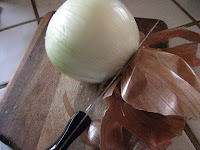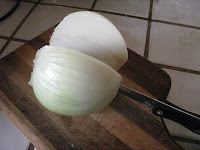After putting up the post about French-fried onions, I realized that many of my friends find preparing onions something to be avoided at all costs. Isn't it inevitable that you will end up with smelly fingers and burning, teary eyes?
Not necessarily! There are of course lots of suggestions out there for avoiding the tears, including some special kitchen goggles just for protecting eyes from the sting. Over the years, however, I have discovered some much simpler ways to avoid the "onion problem." Herewith, ideas that may help you as well:
- If ever there was a time to have a sharp knife to work with, this is it. Dull knives seem to mash the cells of the onions, releasing far more of the volatile smells that lead to tears. I prefer serrated blades for both peeling and cutting onions.
- Stand away from the onion! If you are especially troubled by onion fumes, try to keep them as far away from your face as possible while peeling and cutting. For example, peel them while standing over the sink, with your hands as far down in the sink as you can reach.
- Cut a small slice off the top of the onion and then begin to peel. When possible, pull much of the onion skin off with the blade of your knife rather than cutting it. You want to take off only the papery outer skins. The farther in you cut, the more you will be exposing yourself to the source of tear-problems.
- If you really struggle with onion odors, you can peel the onion under water at the sink. However, this makes it quite a bit harder to get the skin off. When the onion is peeled, however, you are still going to have to move to the cutting board to do the dicing and slicing.
- In general, it will be easier to take the peeling off if you do not cut the root end off until most of the rest of the peeling is removed.
- Use a cutting board! Unless you are making onion rings, cut the onion from pole to pole instead of around the equator. Then lay half the onion flat on the board and cut into pieces of the desired size. If you want onion rings, cut in half at the equator of the onion and then, balancing carefully, begin cutting the onion into rings from the center to the ends.
- If you have a very large amount of onions to chop or slice, you may use your processor (blenders rarely work well to get an even chop). Just be warned--when you take the cover off, the full concentration of vapors will hit you in the face unless you turn your head away!!
- If an onion has some soft spots, you can safely cut these off and use the rest of the onion. However, do be aware that these onions (usually soft because they are beginning to over-ripen) may have a more pungent odor.
- In the same way, onions that have started to sprout are perfectly safe to use--and the sprouted sections will have the flavor of fresh green onions. Just cut away any soft spots that may have formed around the top and around the sprouted sections.
Finally--practice, practice, practice. The more onions you cut, the easier it will get--honest!





No comments:
Post a Comment